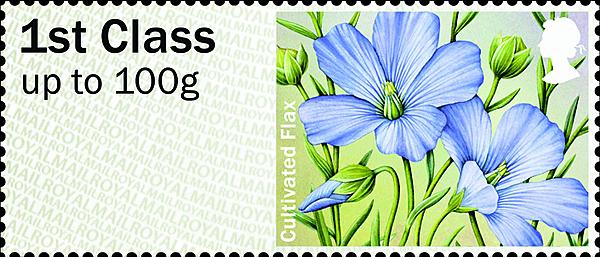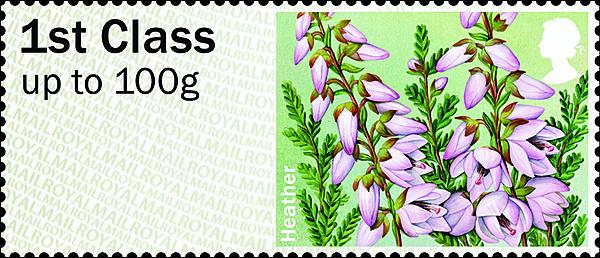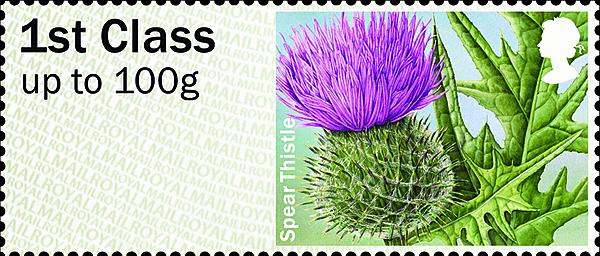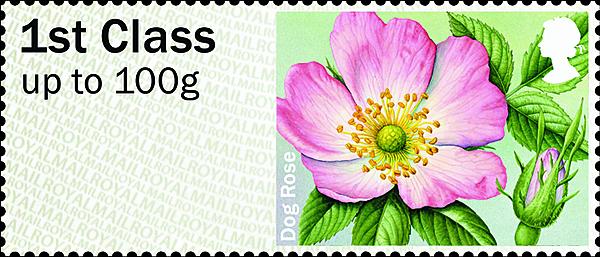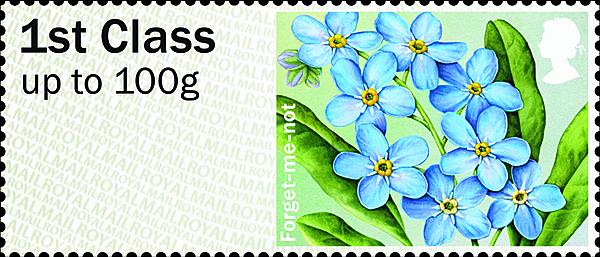World Stamps
Recent British post & go labels feature symbolic flowers
Symbolic flowers are featured in the second set of floral-themed pictorial computer-produced self-adhesive postage labels from Great Britain’s Royal Mail. The six labels were issued Sept. 17.
Royal Mail calls these labels “post & go.” A service indicator is printed on the label at the time of purchase. The examples shown bear the imprint “1st Class up to 100g.”
The new postage labels show forget-me-not, common poppy, dog rose, spear thistle, heather and cultivated flax flowers.
Julia Trickey created the watercolor illustrations for the stamps, and Kate Stephens designed the stamps. The designs include the portrait of Queen Elizabeth II at upper right.
Forget-me-not flowers symbolize remembrance and love. The approximately 50 species of this plant come in many shades of blue, as well as in pink and white. The forget-me-not’s scientific name, Myosotis, is derived from the Greek for “mouse’s ear.”
The red poppy also is associated with remembrance, particularly for remembering sacrifices made during war.
A BBC web page for Remembrance Day explains the connection: “Scarlet corn poppies (Popaver rhoeas) grow naturally in conditions of disturbed earth throughout Western Europe. The destruction brought by the Napoleonic wars of the early 19th century transformed bare land into fields of blood red poppies, growing around the bodies of the fallen soldiers.
“In late 1914, the fields of Northern France and Flanders were once again ripped open as World War One raged through Europe’s heart. Once the conflict was over the poppy was one of the only plants to grow on the otherwise barren battlefields. “
Ahead of Remembrance Day on Nov. 11, Royal Mail will reintroduce the poppy postage label in post & go machines across the United Kingdom.
The rose has served as the national flower of England since Henry VII, who reigned from 1485 to 1509, created the heraldic Tudor rose by combining the red rose of the House of Lancaster with the white rose of the House of York.
The dog rose, a wildflower, is the most widespread of the United Kingdom’s native roses.
Like the rose for England, the thistle is a symbol of Scotland.
The Visit Scotland website of Scotland’s National Tourism Organisation says: “The thistle may only be a humble weed, but it is the emblem of the Scottish nation. The prickly-leaved, pink or purple-flowered ‘Scotch’ thistle is, along with tartan, perhaps the most identifiable symbol of all things Scottish. But how did the thistle earn its place in the heart of the Scots?
“In truth, no-one knows, but legend has it that a sleeping party of Scots warriors were saved from ambush by an invading Norse army when one of the attackers trod on a thistle with his bare feet. His cries raised the alarm, the roused Scots duly defeated the invaders, and the thistle was adopted as the symbol of Scotland. Unfortunately, there is no historical evidence for this, but Scots, like other nations, love a good story.”
One of the last plants to flower in the summer, heather grows on the rocky highlands of Scotland and on heath lands and moors throughout the United Kingdom and western Europe.
Flax is the floral symbol of Northern Ireland, in honor of the historical importance of its linen industry.
On its website, the Thomas Ferguson Irish Linen Co., founded in 1854, said of the flax plant: “Linen is a natural yarn or fabric which comes from the fibres of the stalk of the flax plant (Linum usitatissimum or ‘most useful linen’). The soils most suitable for flax growth are rich loams, without too much clay. It has a single slender stem, with no branches apart from those bearing its flowers.
“The plant is sown in April, produces delicate blue flowers in June and is harvested in August. The subtle intensity of the violet blue flax flower is a sign of the finest fibres and these are used to produce Thomas Ferguson Irish Linen. Other varieties of flax have a pinkish white blossom and produce poorer fibres and yarns.”
The preprinted elements of the labels were produced by International Security Printers by gravure. Each label measures 56 millimeters by 25mm.
This year’s series featuring wildflowers and plants began Feb. 19 with postage labels picturing spring blossoms. The third set, which will show winter greenery, is scheduled to be issued Nov. 13.
Previous sets of pictorial postage labels featured freshwater life (2013), farm animals (2012) and birds (2010 and 2011).
The postage labels are available from terminals in almost 350 post office branches throughout the United Kingdom. The terminals allow customers to weigh their letters and packages, pay the postage and print the appropriate label.
Royal Mail says that it plans to upgrade the machines this year and next.
For more information, contact Royal Mail, Tallents House, 21 S. Gyle Crescent, Edinburgh EH12 9PB, Scotland; or visit www.royalmail.com.
MORE RELATED ARTICLES
Headlines
-
Postal Updates
Oct 7, 2024, 5 PMUSPS plans to raise postal rates five times in next three years
-
US Stamps
Oct 7, 2024, 3 PMMcMurtrie dismissed as APS education director following Sept. 21 arrest
-
US Stamps
Oct 7, 2024, 12 PMVasiliauskas named president of Mystic Stamp Co.
-
US Stamps
Oct 6, 2024, 5 PMApgar souvenir card available
